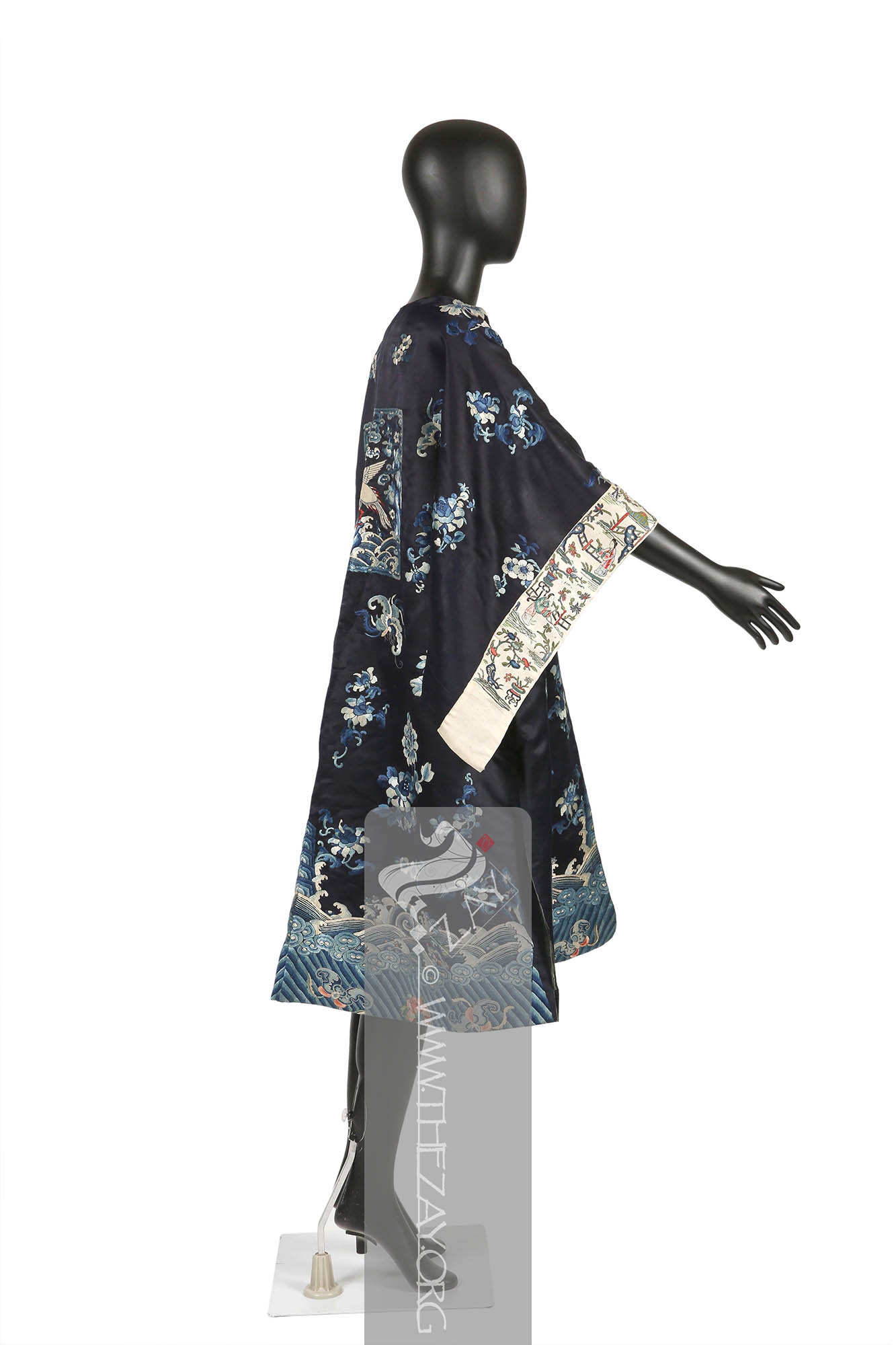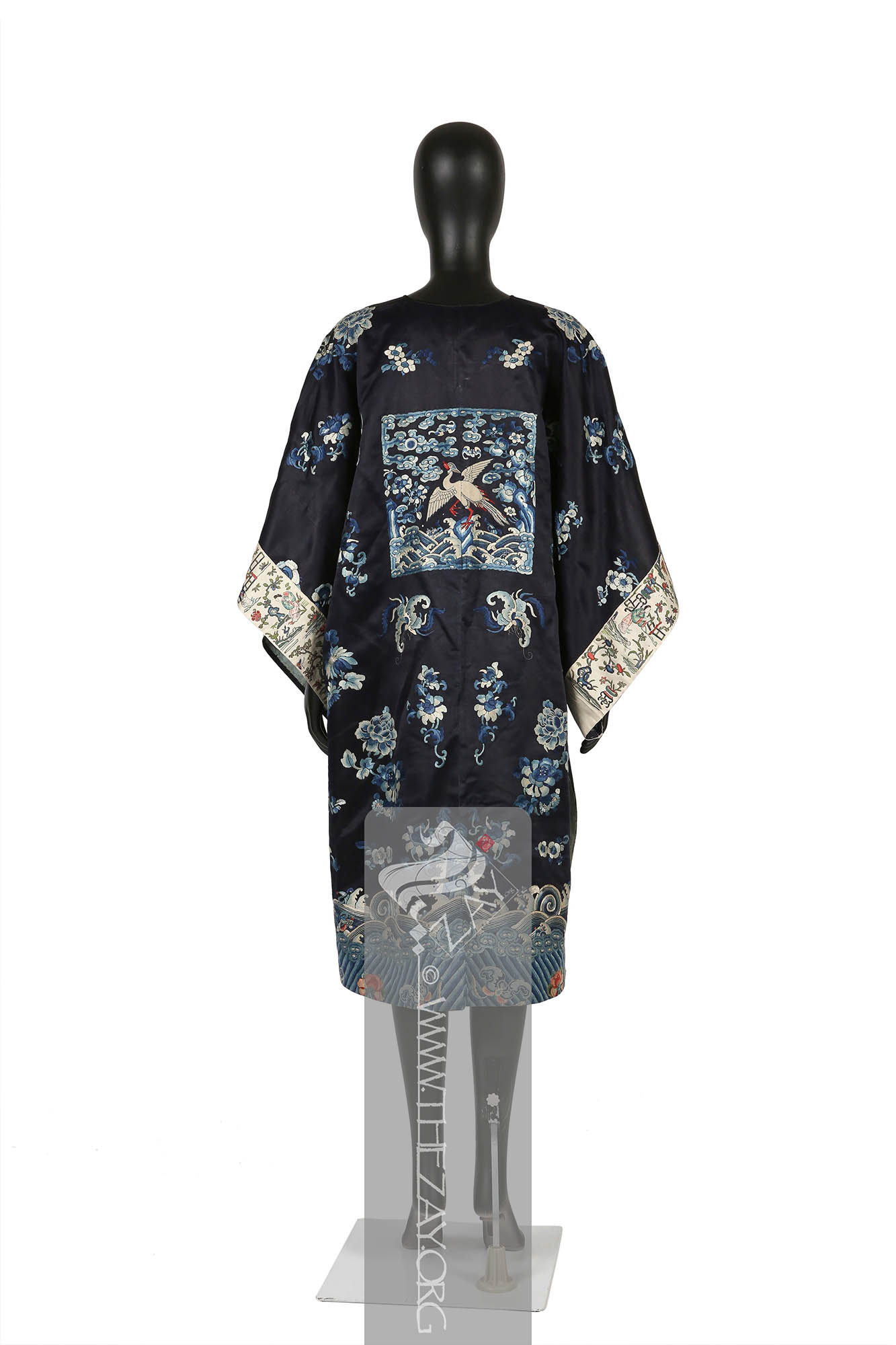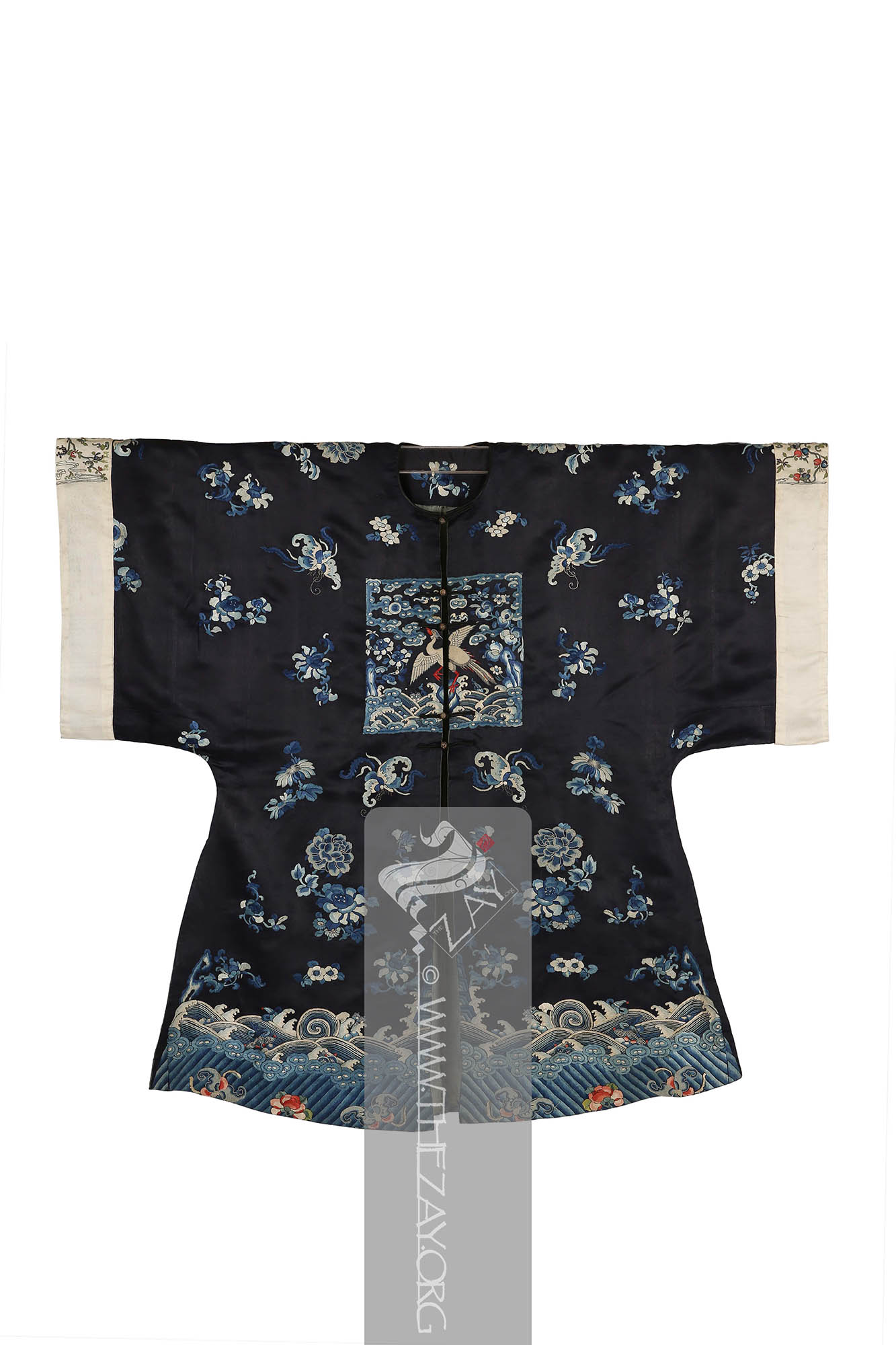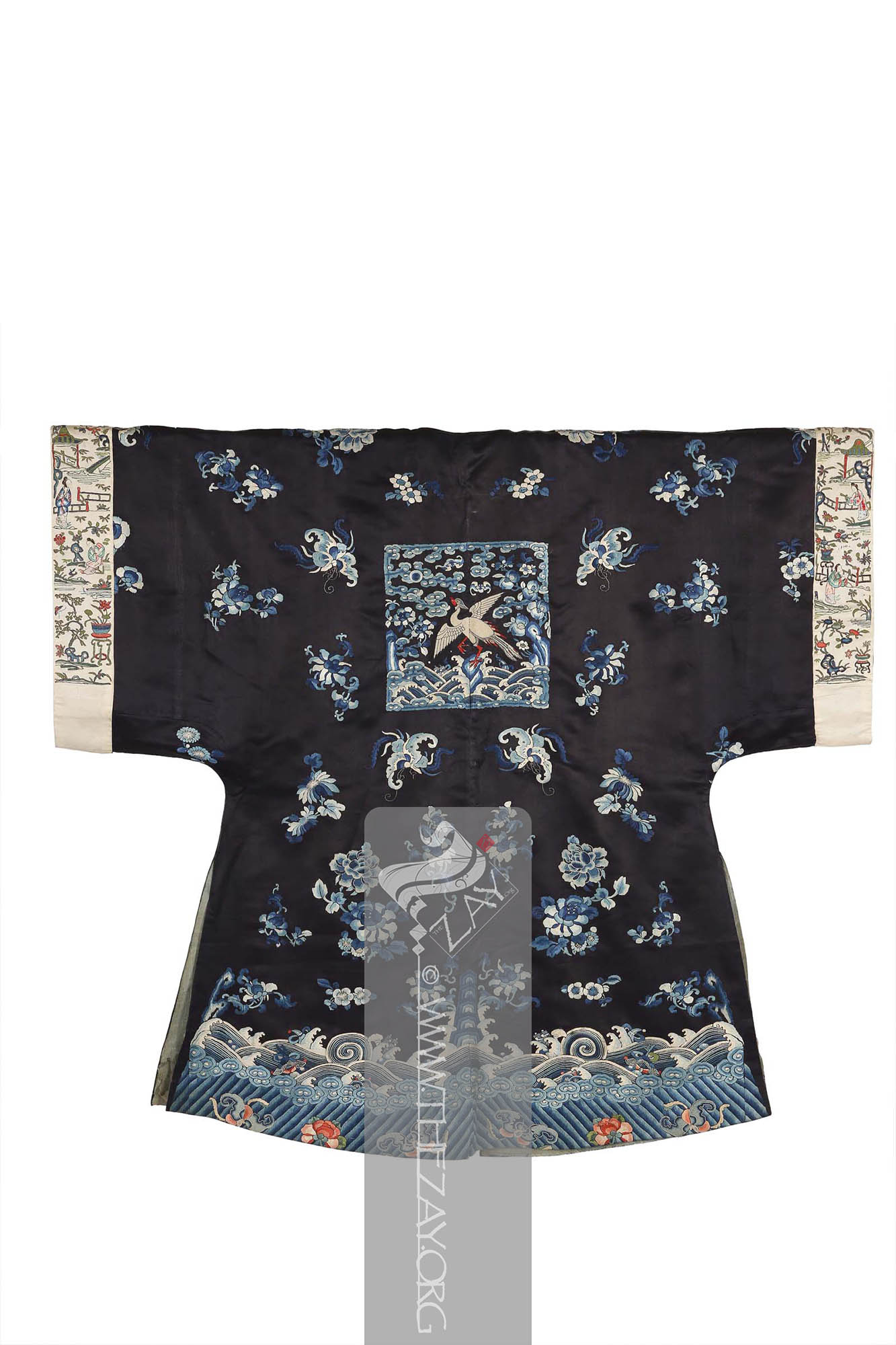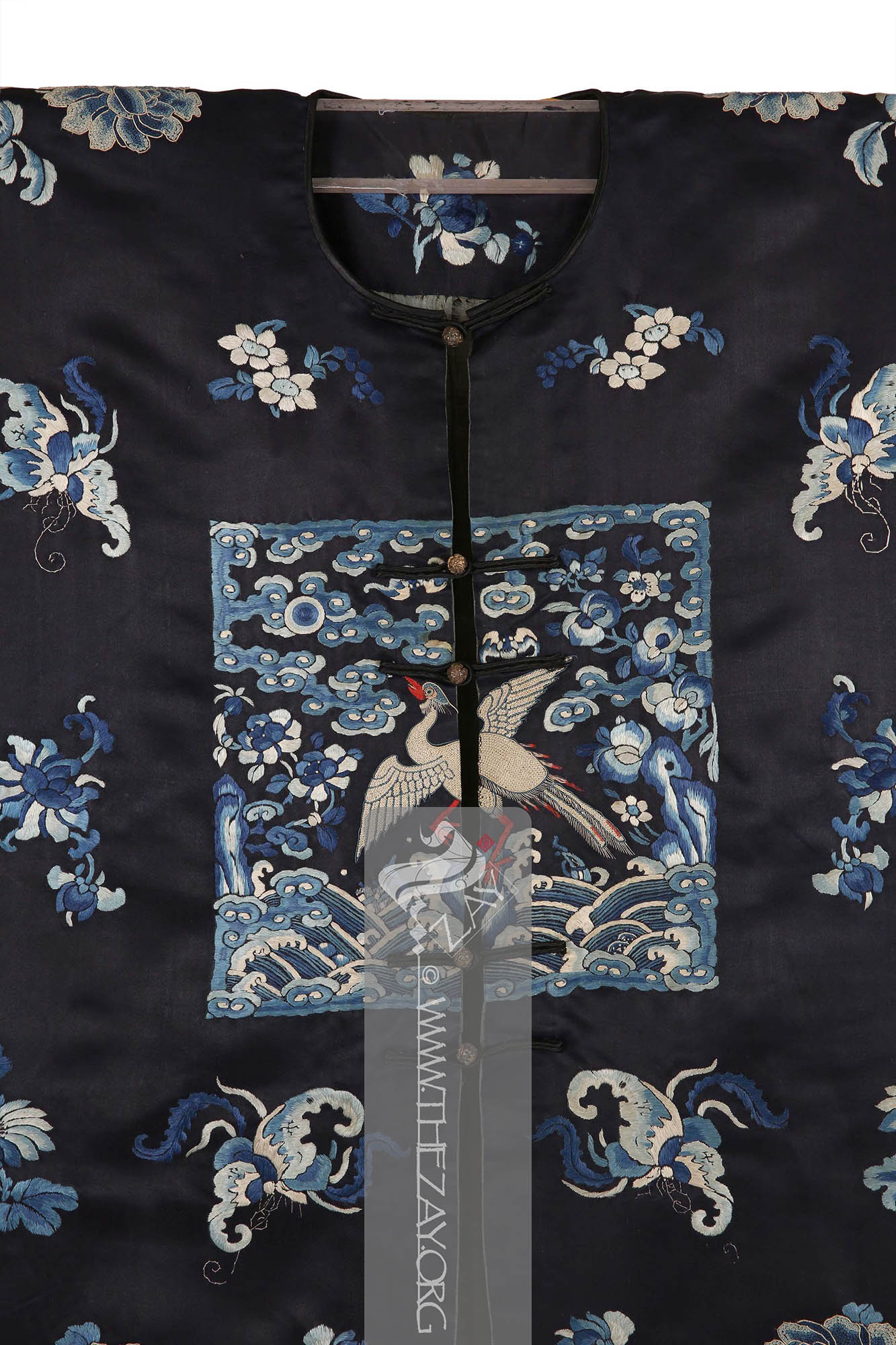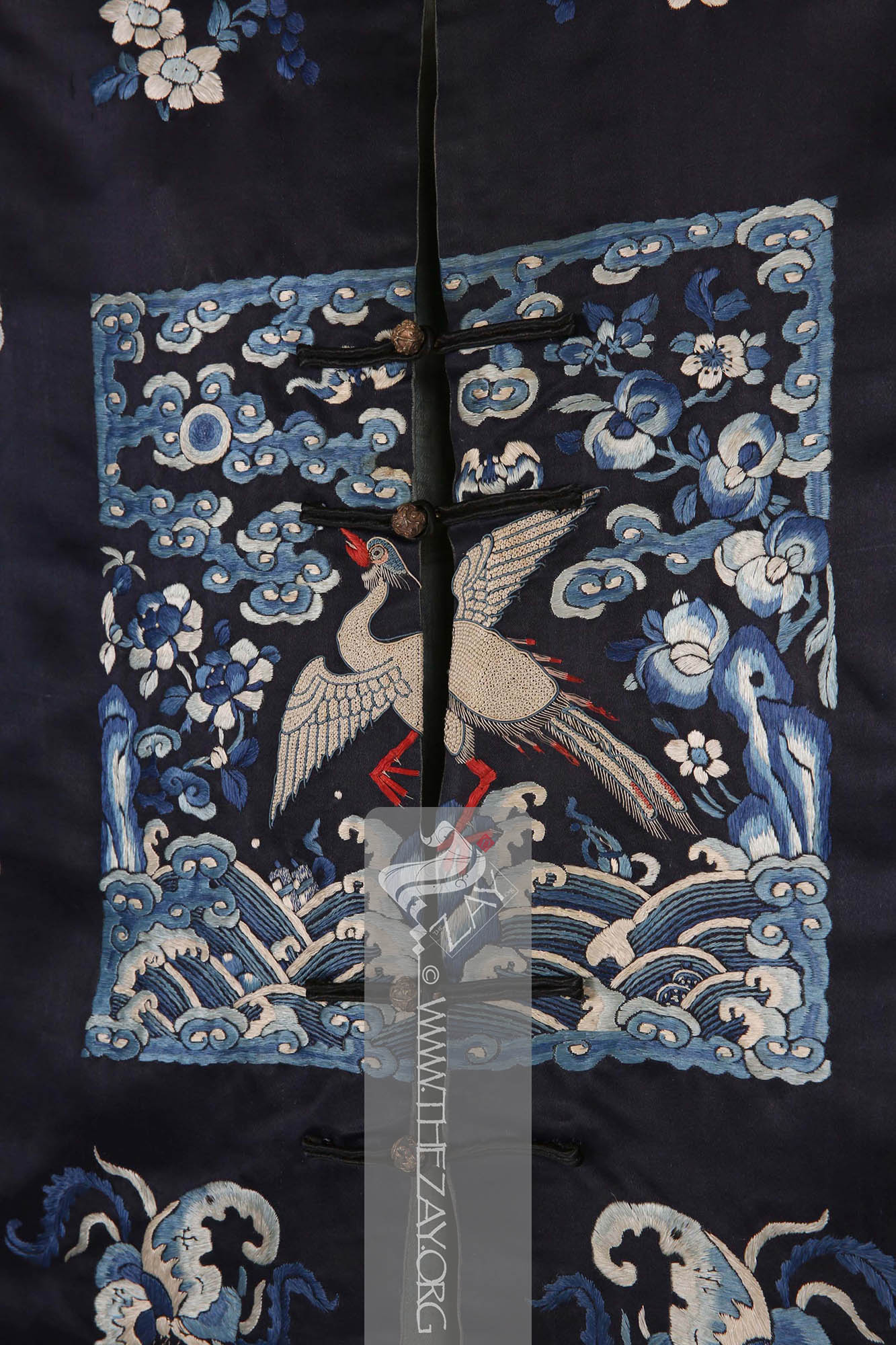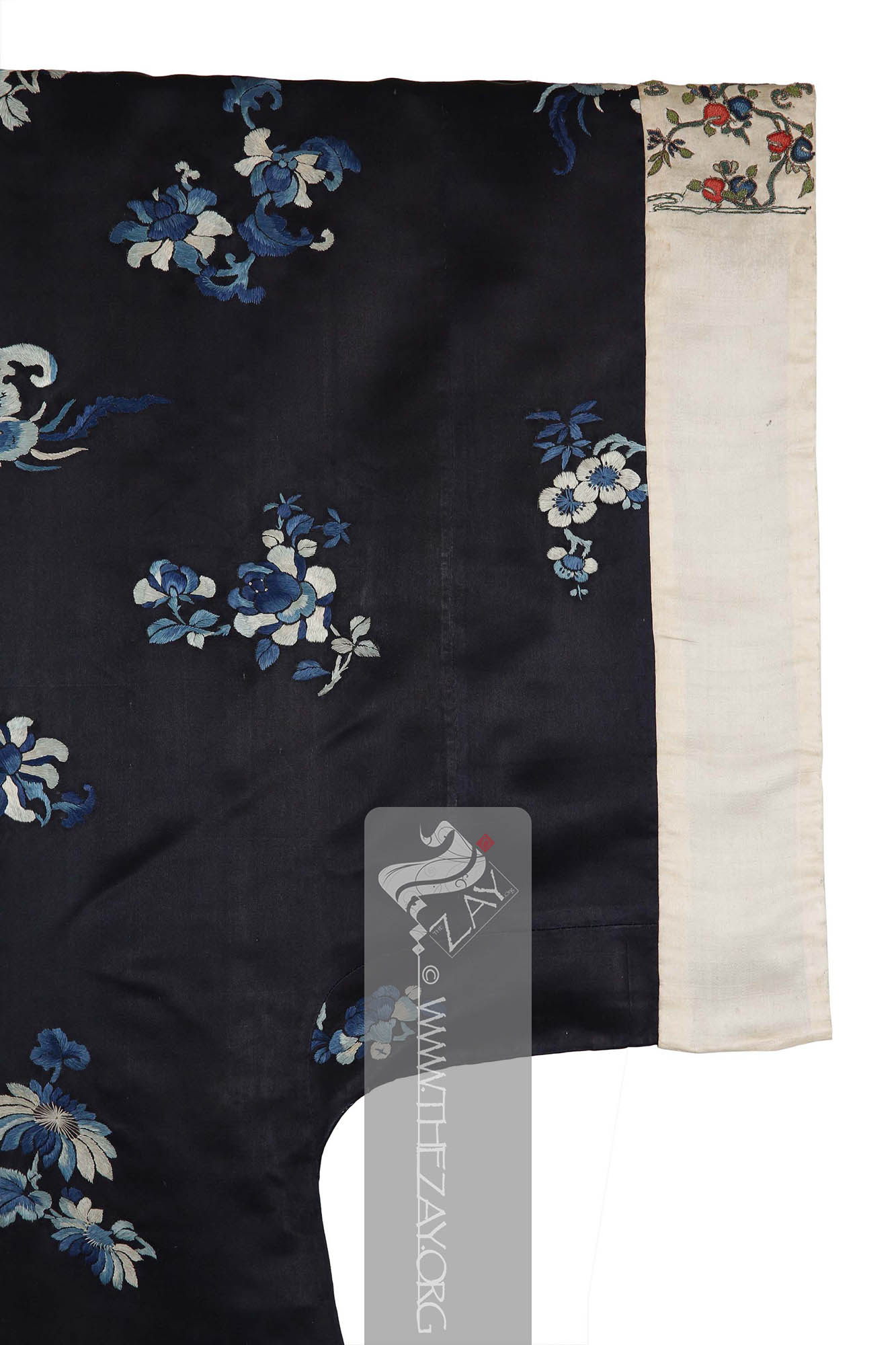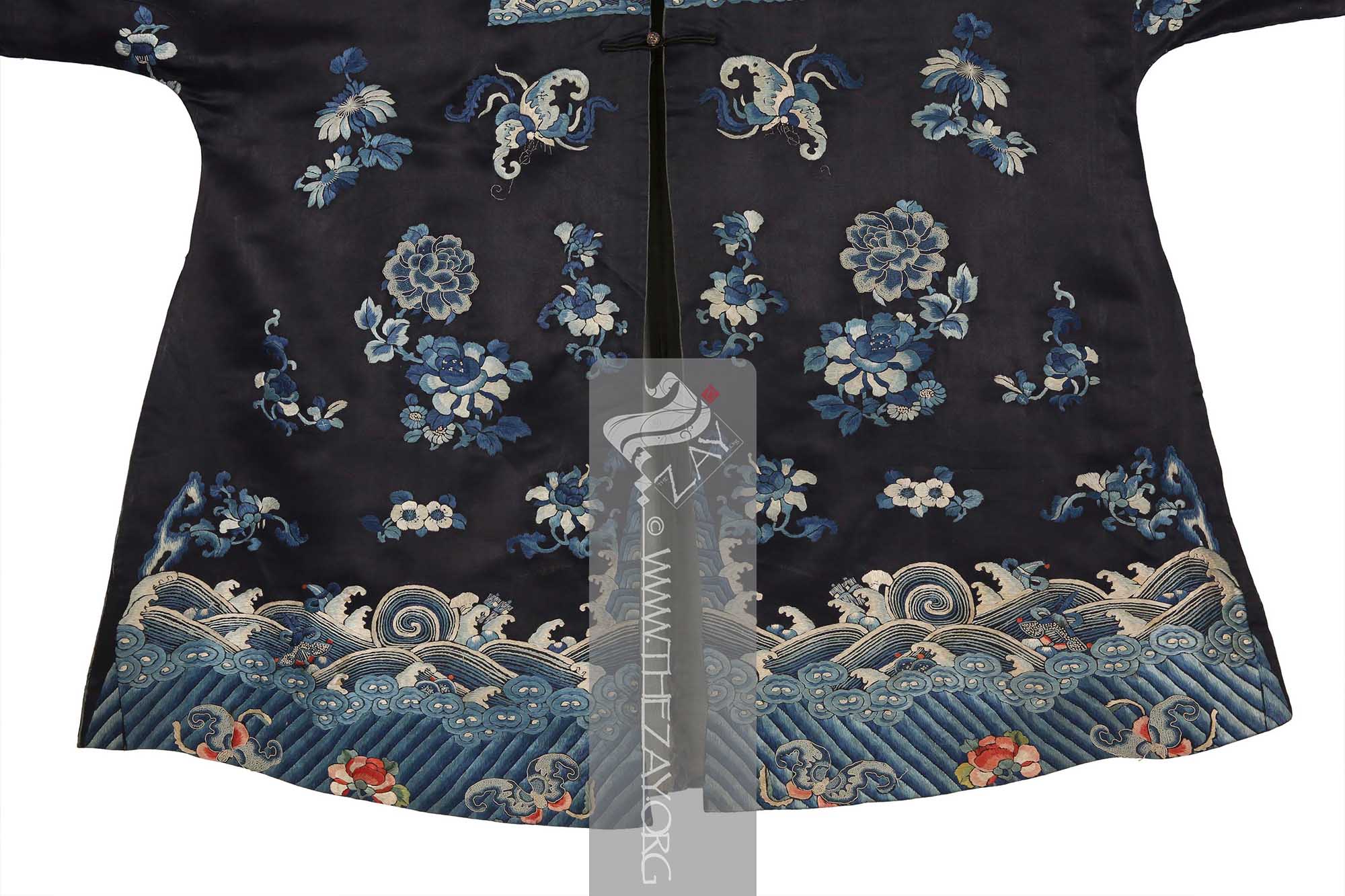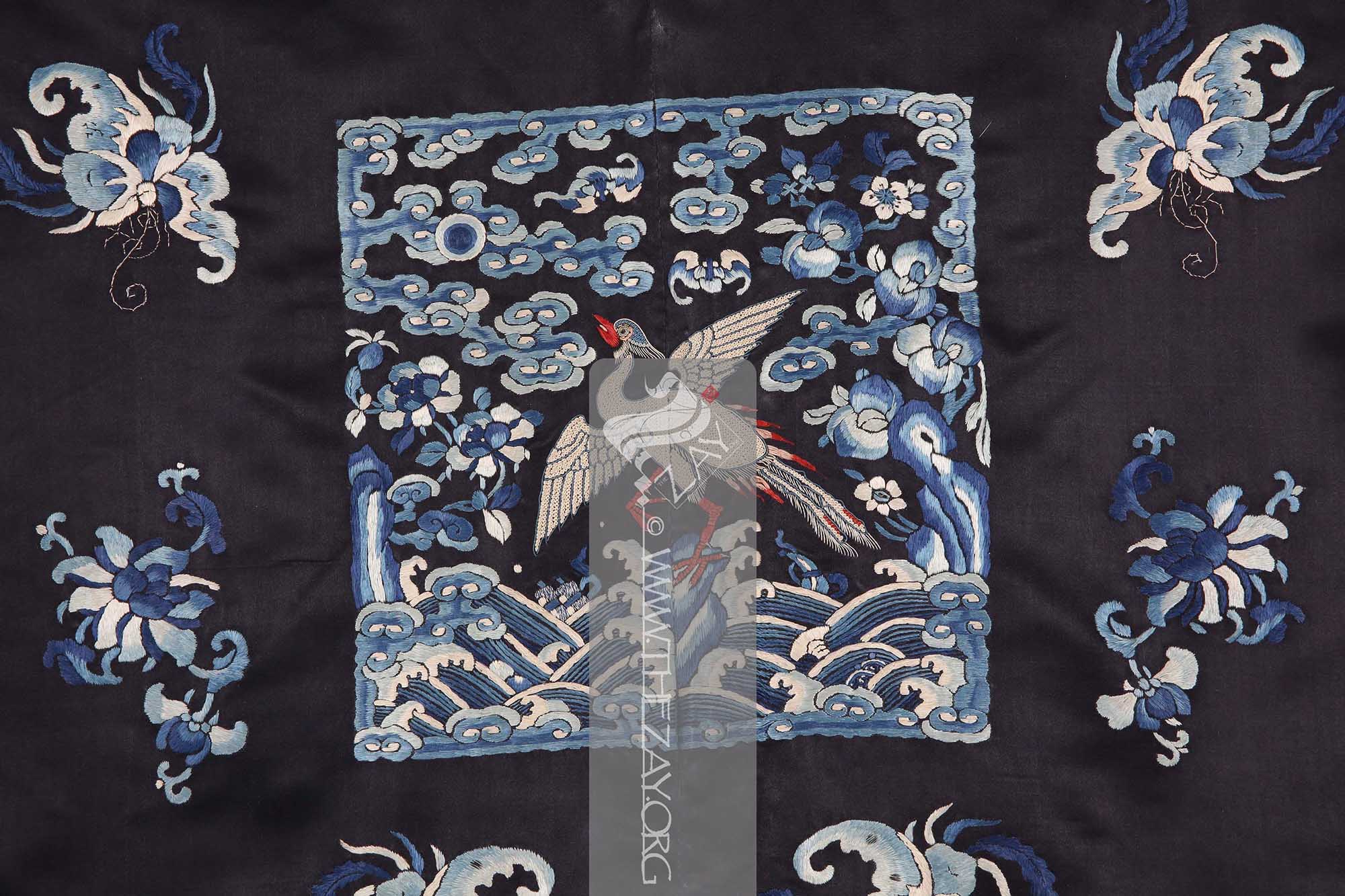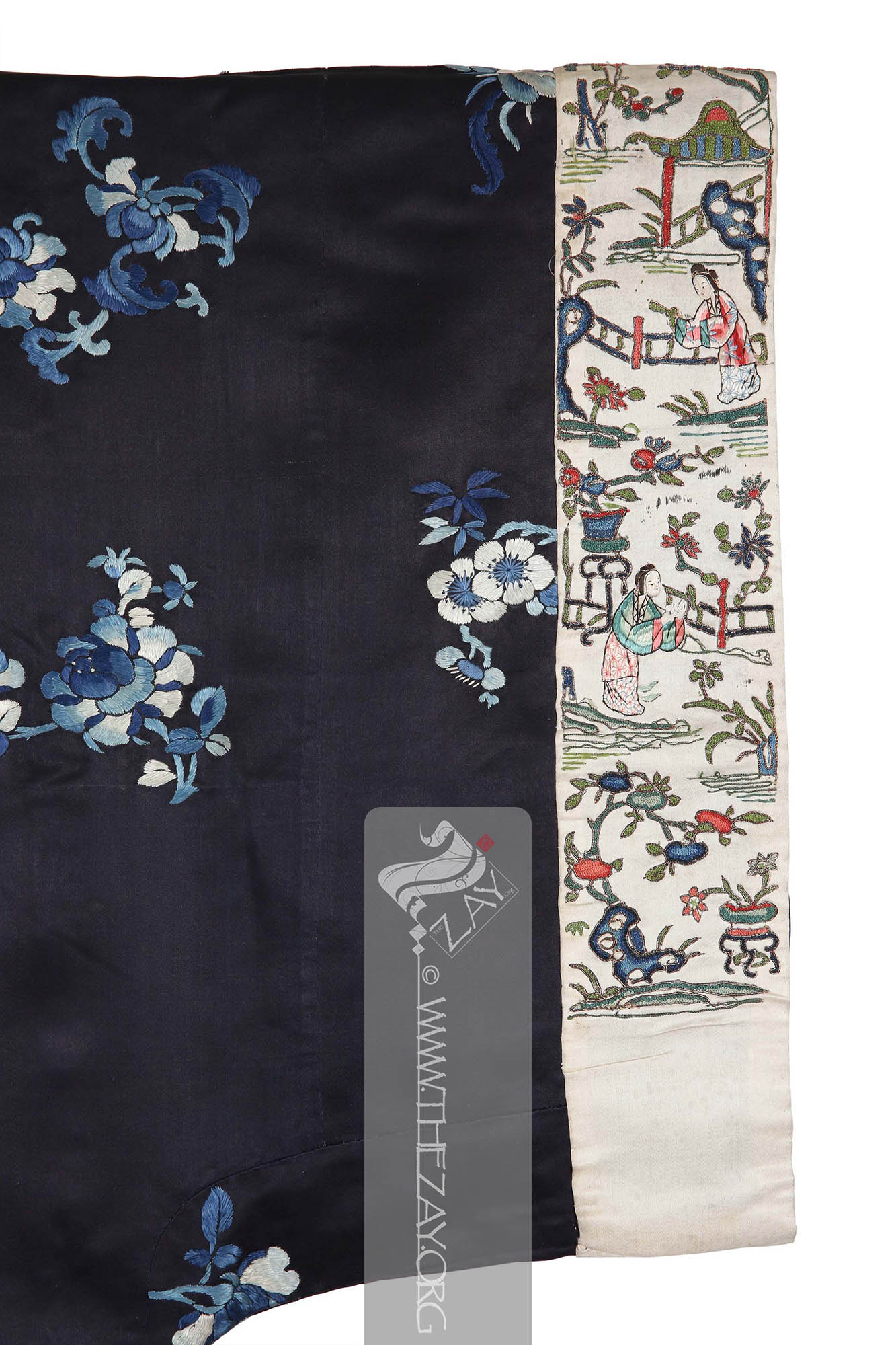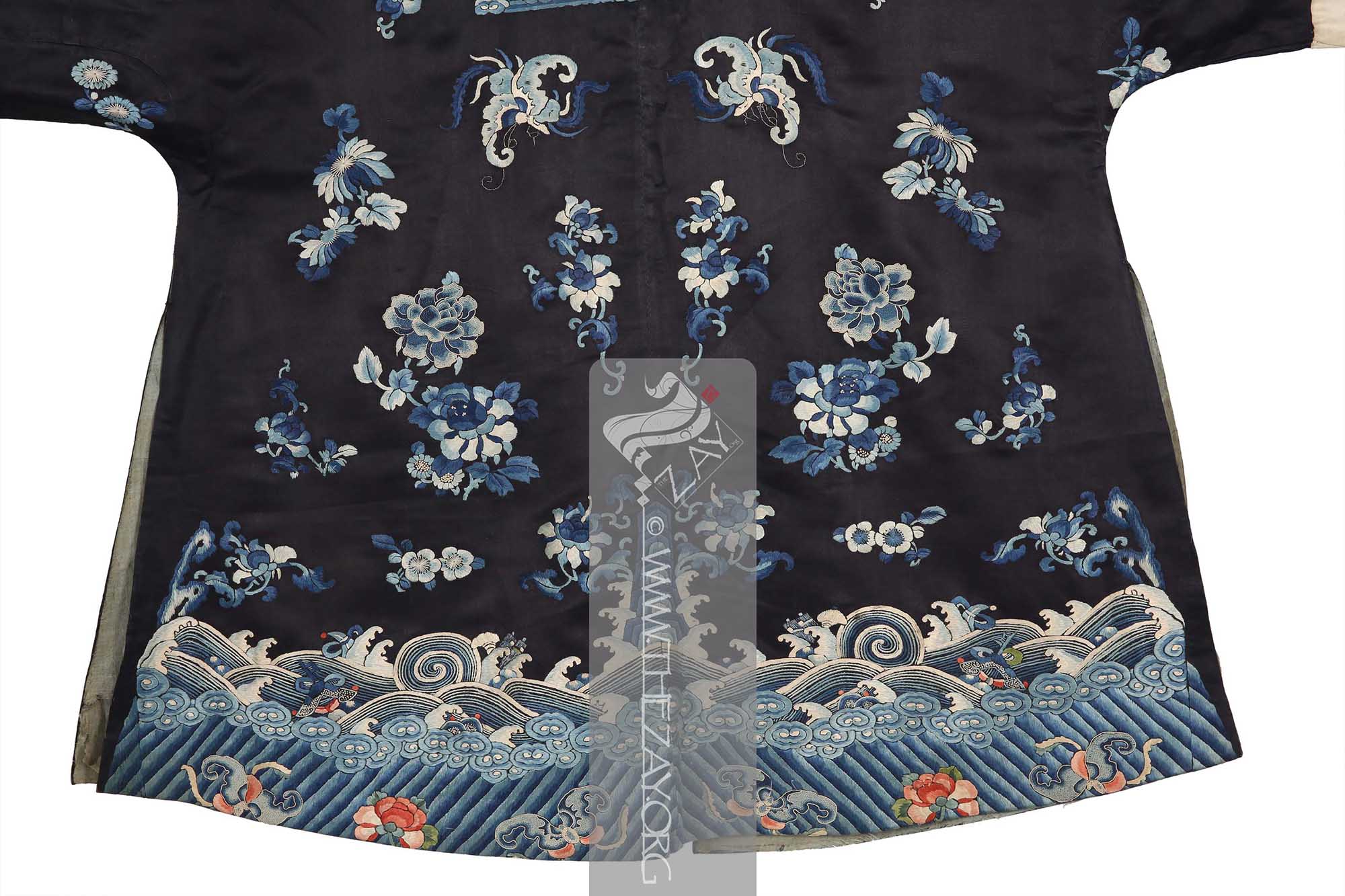Object HistoryThis rich navy blue (
satin
Sātin: (Arabic: Zaytuni: from Chinese port of Zayton in Quanzhou province where it was exported from and acquired by Arab merchants), one of the three basic types of woven fabric with a glossy top surface and a dull back. Originated in China and was fundamentally woven in silk.) (
bufu
Bufu: Traditional formal surcoats with rank badges reserved for imperial Chinese civil and military officers and their wives and children for attending civil and domestic ceremonies at court. ) robe or (
surcoat
Surcoat: (Old French: sur – over), is a loose robe or outer coat that could sometimes be worn over an armour and is worn as a part of an insignia of an order of imperial guards or a knighthood. ) dating back to c. late 19th century was purchased by Dr. Reem El Mutwalli from Kerry Taylor auctions in 2015 to be incorporated in the
Zay
Zay: (Arabic: costume, Pl. azyaā’), a set of clothes in a style typical of a particular country or historical period. Initiative collection.
Object Features This Qing Dynasty silk
surcoat
Surcoat: (Old French: sur – over), is a loose robe or outer coat that could sometimes be worn over an armour and is worn as a part of an insignia of an order of imperial guards or a knighthood. in a rich navy blue
satin
Sātin: (Arabic: Zaytuni: from Chinese port of Zayton in Quanzhou province where it was exported from and acquired by Arab merchants), one of the three basic types of woven fabric with a glossy top surface and a dull back. Originated in China and was fundamentally woven in silk. weave base dates back to c. late 19th century. The coat has ball-shaped metal buttons possibly either in brass or silver with
satin
Sātin: (Arabic: Zaytuni: from Chinese port of Zayton in Quanzhou province where it was exported from and acquired by Arab merchants), one of the three basic types of woven fabric with a glossy top surface and a dull back. Originated in China and was fundamentally woven in silk. loops as fasteners.
The design elements and motifs on the robe are filled with a variety of floral and animal symbolisms with deep significance adhering to strict sumptuary laws common to the period, especially in the royal court.
It is embellished with a combination of (
satin_stitch
Satin_stitch: (Synonym: Damask Stitch), is a type of flat embroidery stitch that creates a satin like smooth and shiny surface by closely spaced stitches, covering an entire area or shape.), (
Peiking_knot
Peiking_knot: (Chinese: Peiking – old name of Beijing capital of China; Synonym – Chinese_knot), is a Chinese traditional knotted embroidery technique that involves creating raised, textured designs using small, tight knots. It originated in the Ming Dynasty and was popularized in the Qing Dynasty. ) or (
Chinese_knot
Chinese_knot: (Synonym: Peiking_knot), is a Chinese traditional knotted embroidery technique that involves creating raised, textured designs using small, tight knots. It originated in the Ming Dynasty and was popularized in the Qing Dynasty. ) and (
chain_stitch
Chain_stitch: An embroidery technique where a looped stitch is made in a continuous chain-like pattern. Each stitch is formed by looping the thread through the previous stitch, creating a linked chain. ) embroidery style done by hand in silk
floss
Floss: (Old French: flosche – nap of velvet), is a type of silk fibre obtained from the cocoons of wild silkworms. It is characterized by its long, fluffy fibers that are not tightly woven, making it ideal for use in various textile applications such as embroidery, lace-making, and sewing. threads primarily of ivory, blue and grey shades. The entire field of the robe is scattered with peonies and lotuses in full bloom and butterflies in flight in
satin_stitch
Satin_stitch: (Synonym: Damask Stitch), is a type of flat embroidery stitch that creates a satin like smooth and shiny surface by closely spaced stitches, covering an entire area or shape. embroidery.
The ivory stain band on the sleeves is embellished with scenic countryside landscapes executed primarily in
Peiking_knot
Peiking_knot: (Chinese: Peiking – old name of Beijing capital of China; Synonym – Chinese_knot), is a Chinese traditional knotted embroidery technique that involves creating raised, textured designs using small, tight knots. It originated in the Ming Dynasty and was popularized in the Qing Dynasty. as well as
satin_stitch
Satin_stitch: (Synonym: Damask Stitch), is a type of flat embroidery stitch that creates a satin like smooth and shiny surface by closely spaced stitches, covering an entire area or shape.. A square pattern depicting a Paradise Flycatcher in flight rising from a wavy water body towards a circular figure resembling either a sun or a moon amongst rolling clouds is split into two halves along the front opening of the robe. This section is also almost completely executed in
satin_stitch
Satin_stitch: (Synonym: Damask Stitch), is a type of flat embroidery stitch that creates a satin like smooth and shiny surface by closely spaced stitches, covering an entire area or shape. embroidery except the figure of the bird which is executed in
Peiking_knot
Peiking_knot: (Chinese: Peiking – old name of Beijing capital of China; Synonym – Chinese_knot), is a Chinese traditional knotted embroidery technique that involves creating raised, textured designs using small, tight knots. It originated in the Ming Dynasty and was popularized in the Qing Dynasty. in ivory and
coral
Coral: (Greek: korallion, probably from Hebrew: goral – small pebbles), is a pale to medium shade of pink with orange or peach undertones, resembling the colour of certain species of coral..
The hem of the robe shows a stormy water body on the far end depicted through rolling waves in the background and a calmer foreground depicted through the (
lishui
Lishui: (Chinese: lishui – standing water) or (stripes), is a set of multicoloured diagonal lines either straight or wavy running parallel to each other forming a pattern that depicts calm sea waves. ) stripes that symbolises standing water. The rolling waves are executed in
chain_stitch
Chain_stitch: An embroidery technique where a looped stitch is made in a continuous chain-like pattern. Each stitch is formed by looping the thread through the previous stitch, creating a linked chain. style of embroidery while the rest of the water is executed in
satin_stitch
Satin_stitch: (Synonym: Damask Stitch), is a type of flat embroidery stitch that creates a satin like smooth and shiny surface by closely spaced stitches, covering an entire area or shape. style. Other elements mostly floral in nature are shown floating on the waves which are executed using both
Peiking_knot
Peiking_knot: (Chinese: Peiking – old name of Beijing capital of China; Synonym – Chinese_knot), is a Chinese traditional knotted embroidery technique that involves creating raised, textured designs using small, tight knots. It originated in the Ming Dynasty and was popularized in the Qing Dynasty. and
satin_stitch
Satin_stitch: (Synonym: Damask Stitch), is a type of flat embroidery stitch that creates a satin like smooth and shiny surface by closely spaced stitches, covering an entire area or shape. techniques in pink and
coral
Coral: (Greek: korallion, probably from Hebrew: goral – small pebbles), is a pale to medium shade of pink with orange or peach undertones, resembling the colour of certain species of coral. silk
floss
Floss: (Old French: flosche – nap of velvet), is a type of silk fibre obtained from the cocoons of wild silkworms. It is characterized by its long, fluffy fibers that are not tightly woven, making it ideal for use in various textile applications such as embroidery, lace-making, and sewing. threads.
The back of the robe resembles the front in all its depiction and execution of the design elements and motifs except that the central square patch with the bird is not split in two halves. In fact, it is a single piece. The lining of the robe is in a thin light blue silk (
damask
Dāmāsk: (Arabic: Damascus – a city in Syria), is a luxurious fabric woven with reversible patterns typically in silk, wool, linen, or cotton. Originating in China, the fabric was perhaps introduced to European traders at Damascus – a major trading post on the Silk Road with a thriving local silk industry. ) which is quite frayed, however, the back of the neck is an extension of the front navy
satin
Sātin: (Arabic: Zaytuni: from Chinese port of Zayton in Quanzhou province where it was exported from and acquired by Arab merchants), one of the three basic types of woven fabric with a glossy top surface and a dull back. Originated in China and was fundamentally woven in silk. field with a
satin_stitch
Satin_stitch: (Synonym: Damask Stitch), is a type of flat embroidery stitch that creates a satin like smooth and shiny surface by closely spaced stitches, covering an entire area or shape. embroidered floral motif.
It is interesting to note that robes like this with rank badges – buzi – often called Mandarin Squares by collectors were worn as signifiers of civil, military, or imperial court rank. The practice gained popularity, especially during the Ming (1368-1644) and Qing (1644-1912) periods.
Nine ranks each for civil and military positions were bestowed upon the emperor’s royal advisory councils as well as army generals. Civil badges displayed nine different birds in contrast to the nine animal figures displayed on military badges – in this case, a Paradise Flycatcher which represented the 9th-ranking civil officer’s post.
Usually, there was a sun depicted on either the left or the right of the bird or the animals corresponding to the side of the person’s position next to the emperor in the royal court. While the sun would usually be depicted in shades of orange or red, this robe is an anomaly as the circular motif resembling a sun is in fact in blue and not red.
Furthermore, the civil rank holders would sit to the left of the emperor with their birds both front and back facing the emperor – thus the right of the wearer. Alternatively, their wives’ badges for social events would mirror their husbands’ as they sat on the right side of their respective husbands – thus having their bird face to the left of the wearer. Once we apply this theory to this piece it could be concluded that this piece was a man’s robe.
With just a handful of countries earning mentions in the “Object range” section due to technical limitations, one must never forget the vast range of influence the Chinese culture has had across the globe, especially in South and Central Asia, southeast Asia, and the Middle East. Chinese politics and administration spanning the Ming and Qing period influenced all of southeast Asia especially its neighbouring countries like Vietnam and Korea, which too adopted similar robes with insignias for their respective government officials.
Links 




